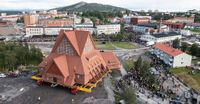In a feat of engineering and cultural preservation, one of Sweden’s most cherished architectural landmarks—the 113-year-old Kiruna Church—began its slow, stately journey to a new home this week. The grand, red wooden church, a fixture on a hill in Kiruna, Sweden’s northernmost city, is being relocated in its entirety over a three-mile (five-kilometer) stretch to save it from the shifting ground caused by decades of iron ore mining beneath the town. The move, which kicked off on Tuesday, August 19, 2025, is expected to take two days and has drawn both local crowds and international attention, according to reports from Reuters, BBC, and France 24.
The Kiruna Church, known locally as Kiruna Kyrka, was built in 1912 and is widely considered one of Sweden’s most beautiful buildings. With its striking neo-Gothic design, slanting roofs, and distinctive red hue, the church has long been a spiritual and cultural beacon for the town’s 18,000 residents. Its pews even feature designs inspired by the region’s Indigenous Sami people, a nod to the area’s rich and sometimes contested heritage, as noted by AFP and The New York Times.
But the church’s survival was thrown into question when the world’s largest underground iron ore mine—operated by the Swedish state-owned company LKAB—began expanding ever deeper beneath Kiruna. The resulting ground instability threatened not only the church but the entire old town center. “Cracks in the foundation caused by decades of iron ore mining have forced its relocation,” reported Straight Arrow News. Engineers warned that, while the fissures weren’t immediately life-threatening, they would eventually undermine essential infrastructure like water, electricity, and sewage systems.
The relocation of the church is just one chapter in a much larger saga: the gradual move of Kiruna’s entire city center, a process that began nearly two decades ago and is expected to continue for years. Since 2004, about two dozen buildings have been moved, with LKAB footing the bill—an effort projected to cost around $1 billion, according to Reuters. The new city center, inaugurated in 2022 about two miles east of the original, is now welcoming its most iconic resident.
Moving the church itself is a logistical marvel. The 672-metric-ton (741-ton), 130-foot-wide structure was first lifted off its concrete foundation using a system of steel beams and hydraulic jacks, as detailed by The New York Times. It was then carefully placed onto two long, remote-controlled flatbed trailers—self-propelled modular transporters (SPMTs)—with a convoy totaling about 1,200 tons. The convoy inched along at a pace of just half a kilometer an hour, with workers in yellow vests and helmets constantly measuring, checking, and adjusting to keep the precious cargo safe. “The biggest challenge was preparing the road for such a wide building,” project manager Stefan Holmblad Johansson told the BBC. “We’ve widened it 24 meters (79 feet) and along the way we removed lamp posts, traffic lights, as well as a bridge that was slated to be demolished anyway.”
The operation began with a blessing from Bishop Åsa Nyström of Luleå and parish vicar Rev. Lena Tjärnberg, who stood before the suspended church and prayed for its safe passage. “Now we surrender the church into God’s hands,” Bishop Nyström said, according to local media cited by The New York Times. The belltower, which stands separately next to the church, is scheduled to make its own journey next week.
The move has captivated the town and the nation. Thousands of locals and tourists lined the streets, while Swedish television broadcast the entire journey live—a new twist on the country’s popular “slow TV” trend. The festivities don’t end with the church’s arrival: a multi-day celebration is planned, including performances by well-known Swedish acts (even this year’s Eurovision representatives) and a royal visit from King Carl XVI Gustaf.
For many, the event is bittersweet. “It’s quite remarkable to be able to move such a building,” French tourist Elisabeth Turq told AFP. Katarina Notti, a local nursery schoolteacher, echoed the sentiment to Reuters: “It’s amazing that one can move such a large building. But at the same time it feels a bit sad that it is leaving this beautiful place.” Sami author Ann-Helén Laestadius, whose novel "Stolen" was recently adapted for Netflix, summed up the complex feelings: “I’m glad the church is being moved... anything else would have been a scandal. It’s such a big part of Kiruna’s soul. But it is extremely difficult to see your town disappear.”
Not everyone, however, sees the move as purely positive. Some members of Sweden’s Indigenous Sami community have voiced concerns about the broader impact of mining and relocation on their traditional lands and livelihoods, particularly reindeer herding. “The moving of the church is a symbol of which culture the state considers worth protecting—and it is not the Sami one,” stated Min Odda Giron, a group representing two Sami villages, as reported by The New York Times.
The church’s preservation has been a priority for LKAB and the town’s planners. “This is not just any building, it’s a church,” said project manager Stefan Holmblad Johansson to AFP, emphasizing the care taken to protect the church’s large organ—boasting more than 2,000 pipes—and its pastel landscape altarpiece painted by Sweden’s Prince Eugen. The neo-Gothic exterior and national romantic interior, with touches of Art Nouveau, were all meticulously safeguarded for the journey.
Comparisons have been drawn to other monumental relocations, such as the 2008 move of Alexander Hamilton’s home in Manhattan. But as LKAB’s chief executive Jan Moström told AFP, “Hopefully tomorrow will be a walk in the park again,” reflecting both the anxiety and excitement surrounding the project.
The relocation effort has not only preserved a beloved landmark but also highlighted the intersection of industrial progress, cultural heritage, and community identity in a changing world. As Kiruna’s church inches toward its new home, it carries with it not just timber and stained glass, but the hopes, memories, and complicated emotions of an entire town.

